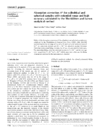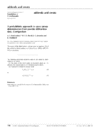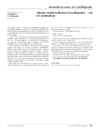issue contents
November 2012 issue

Cover illustration: The sequence of constructing the cartwheel pattern of the first-level hierarchy of the quasi-periodic pattern on the interior walls of the courtyard of the Madrasa of al-'Attarin (1323), Fez, Morocco [Al Ajlouni (2012). Acta Cryst. A68, 235-243].
feature articles
Free 

In the 1960s the first examples were found of crystals which were not lattice periodic but quasiperiodic (a more general notion), contradicting the prevailing idea that crystals should be lattice periodic. The most interesting class of these aperiodic crystals was that of quasicrystals, discovered in 1982 by Dan Shechtman. A brief history of the development of the field of aperiodic crystals is given.
research papers
Download citation


Download citation


An algorithm for joint multipolar charge and spin refinement against X-ray and polarized neutron diffraction data is described and applied for the first time to molecular magnetic crystals. This algorithm is implemented in the software MOLLYNX.
Keyhole electron diffractive imaging is a new technique for imaging the structure of a crystalline specimen at sub-ångström resolution with a transmission electron microscope. The method is demonstrated by simulations and experiments.
Expectation values of a Poisson-distributed random number are derived for the well known positive integer powers and for as yet not known negative integer powers.
Tests were carried out to determine whether the Hansen–Coppens multipolar model is accurate enough to study changes of electrostatic properties under the influence of a crystal field. The study revealed that electrostatic properties obtained from the multipolar model are significantly different from those obtained from theoretical cluster or perturbation theory calculations.
Three charge-density models were tested against theoretical and experimental X-ray diffraction data and the resulting molecular dipole moments are compared.
In order to investigate the focusing behavior in a curved multi-plate crystal cavity under the back-diffraction condition, a modified algorithm for X-ray dynamical diffraction theory is presented.
The use of Friedel averages and differences is described for the following operations: determining whether a crystal is centrosymmetric or not, determining the point group of a crystal and validating intensity data after structure solution.
Synchrotron powder X-ray diffraction data are analysed with generally available Rietveld refinement software and strategies are suggested for subsequent calculation of maximum-entropy-method charge densities.
All homogeneous sphere packings were derived that refer to the trivariant orthorhombic lattice complexes of the space groups without mirror symmetry belonging to crystal class mmm.
The absorption correction A* for cylindrical and spherical samples over the extended ranges of 0 ≤ μR ≤ 30 and 0 ≤ θ ≤ 90° and with high accuracy is calculated by the Thorkildsen and Larsen analytical method.
addenda and errata
Free 

book reviews
Free 

international union of crystallography
Free 

Free 



 journal menu
journal menu



































